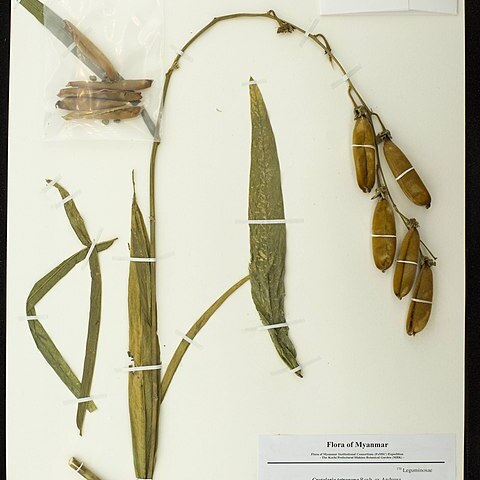Herbs, erect, to 2 m tall. Branches 4-angled, silky pubescent. Stipules linear to linear-lanceolate, 4-5 mm. Leaves simple; petiole ca. 4 mm; leaf blade oblong-elliptic to linear-lanceolate, 10-20(-25) × 1-2.5 cm, both surfaces finely appressed pubescent, midvein abaxially pale and prominent, base broadly cuneate to obtuse, apex acute to slightly acuminate. Racemes terminal or leaf-opposed, 6-10-flowered; bracts lanceolate, 4-6 mm. Pedicel 1-1.5 cm; bracteoles inserted at apex of pedicel, linear, 3-4 mm. Calyx 2-lipped, 1.5-2.5 cm, divided to near base, densely brown pilose; abaxial lobes narrowly triangular-lanceolate, connate for ca. 1/4 of length, 4-5 mm wide at base; adaxial lobes similar, divided to near base. Corolla yellow; standard suborbicular to oblong, ca. 2.5 cm, base with 2 appendages; wings narrowly elliptic to lanceolate-elliptic, ca. 2 cm; keel ± as long as wings, broad and rounded, abaxial margin woolly, beak long, twisted, and exserted beyond calyx. Legume oblong, 4-5 cm, 10-20-seeded, [dark brown tomentose or] densely brownish yellow pubescent. Fl. Sep-Nov, fr. Dec-Feb.
More
A herb. It grows 2 m tall. The branches are 4 angled and have silky hairs. The leaves are simple and narrowly sword shaped. They are 10-20 cm long by 1-3 cm wide. They are hairy. There are 6-10 flowers in a group at the ends of branches or opposite the leaves. They are yellow. The pods are 4-5 cm long and have 10-20 seeds.
Open slopes at elevations up to 1,700 metres in Nepal. Sparse forests, along trails at elevations from 500-1,600 metres in China. Open areas in pine forests and secondary forests dominated by bamboo, at elevations to 2,070 metres.
More
It is a tropical plant. In southern China it grows along trails between 500-1,600 m above sea level.
Can be grown by cuttings or seedlings. Seeds needs soaking.

